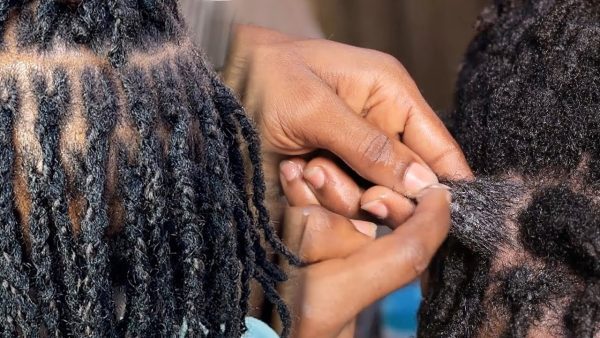Dreadlocks provide a distinctive and one-of-a-kind look, whether you want to rock a dramatic style statement or appreciate your natural texture. In this blog post, we’ll provide a comprehensive guide on how to dreadlock your hair, covering different methods, maintenance tips, and styling techniques.
Understanding Dreadlocks
Dreadlocks, often referred to simply as “dreads,” are a hairstyle characterized by the matting and locking of hair into long, ropelike strands. Although dreadlocks have become more and more fashionable in recent years as a fashion statement and a representation of cultural identity, they have roots in many different civilizations that date back thousands of years.
Many cultures, including ancient Egypt, India, and Greece, have worn dreadlocks. They represented spirituality and social standing in ancient Egypt. They stood for Shiva and defiance of injustice in India. Dreadlocks were also adopted by Jamaican Rastafari adherents.
There are diverse cultural significance of dreadlocks across different societies. While Rastafarians in Jamaica view them as a symbol of their spiritual beliefs and dedication to nature, Maasai warriors in East Africa wear them as a mark of courage.
How to Dreadlock Your Hair
It’s considerably easier to grow out full locs later on if you start dreading your hair when it’s still short. With a brush or comb, you may either form your dreads or twist them. Before your hair is even an inch long, you can begin creating dreadlocks by employing the necessary supplies and techniques. Here is a step-by-step guide on how to dreadlock your hair.
1. Prepare Your Hair
It’s critical to make sure your hair is clean and clear of product buildup before starting the dreadlocking procedure. Use a residue-free shampoo to give your hair a thorough wash and get rid of any oil, debris, or styling products. Your hair should be damp but not drenched after towel-drying.
2. Section Your Hair
Next, section your hair into small, manageable sections using a comb or your fingers. Your dreadlocks’ size will be determined by the section sizes, so choose wisely based on the style you want. To hold the parts apart and secure them during the dreadlocking process, use clips or hair ties.
3. Choose Your Method
Dreadlocking hair can be done in a few different ways, such as backcombing, twisting, and interlocking. Below is a quick synopsis of each method:
- Backcombing: To generate knots and tangles, this technique entails easing the hair towards the roots using a comb or dreadlock instrument.
- Twisting: Twisting is a technique used to get hair to naturally bond together over time by tightly twisting portions of hair.
- Interlocking: Threading portions of hair through one another with a specialized instrument creates tight, consistent dreadlocks.
Select the technique that best fits the texture, type, and desired results of your hair. Additionally, you can try combining different approaches to create a unique style.
4. Dreadlock Your Hair
After deciding on a technique, start dreadlocking your hair, a portion at a time. Using your preferred technique, work systematically from the roots to the ends to encourage the hair to lock together and develop dreadlocks. Make sure that every dreadlock is firmly fastened and well-defined by taking your time and being meticulous.
Maintenance of Dreadlocks
New dreadlocks require regular cleaning and maintenance to ensure their health, freshness, and well-defined appearance. It’s essential to wash using a residue-free shampoo to avoid buildup and preserve freshness. Mildew and stink are avoided by completely drying clothes after washing, but steer clear of high-heat hair dryers.
Using a crochet hook or dreadlock tool to trim loose hairs and tighten any unravelling portions is part of regular care. Buildup can be avoided by utilizing residue-free shampoos and staying away from thick oils, waxes, and gels. Using protective style techniques, like a head wrap, scarf, or cap, can help reduce frizz and friction.
Dreadlocks take time to grow and lock into place, so patience is a must. Excessive manipulation may result in fracture and slow down the locking mechanism. Consult a qualified loctician or dreadlock specialist for assistance if you’re unsure how to care for your dreadlocks or run into any problems.
Styling of Dreadlocks
Dreadlock styling provides people with a multitude of artistic opportunities to convey their individuality and sense of style. A laid-back aesthetic can be achieved by letting dreadlocks loose and flowing, braiding them for dimension and texture, or drawing them back into a ponytail or bun. Beads, charms, wraps, and headbands are examples of accessories that can offer flair and personality. There are countless options for dreadlock styling to fit your taste and lifestyle, whether you like elegant or carefree looks.
Frequently Asked Questions and Answers About How To Dreadlock Your Hair
1. How do I start dreadlocks on my hair?
There are several methods for starting dreadlocks, including backcombing, twisting, and interlocking. Choose a method that best suits your hair type and texture, and follow step-by-step guides or tutorials for that specific technique.
2. How long does it take to dreadlock hair?
The time it takes to dreadlock hair varies depending on factors such as hair type, length, and the method used. On average, it can take several months to a year for dreadlocks to fully mature and lock into place.
3. Can I dreadlock my hair if it’s straight or wavy?
Yes, you can dreadlock straight, wavy, or curly hair. While hair texture may affect the process of dreadlocking, there are techniques and methods available for creating dreadlocks on different hair types.
4. Do I need to use wax or products to dreadlock my hair?
It is possible to dreadlock hair without using wax or products, especially if you prefer a more natural approach. However, some people choose to use wax or specialized dreadlock products to help speed up the locking process and enhance the appearance of their dreadlocks.
5. How often should I wash my hair once I have dreadlocks?
It’s important to keep your dreadlocks clean to prevent buildup and maintain their freshness. Wash your hair regularly with a residue-free shampoo, but avoid over-washing, as this can cause your dreadlocks to unravel or become loose.
6. Can I style my dreadlocks with braids or twists?
Yes, you can style your dreadlocks with braids, twists, or other hair accessories. Experiment with different styles and techniques to create unique and eye-catching looks that showcase your personality and creativity.
7. How do I maintain my dreadlocks once they are formed?
Regular maintenance is key to keeping your dreadlocks healthy and looking their best. This includes washing and drying your hair properly, using a crochet hook or dreadlock tool to tidy up loose hairs, and avoiding heavy products that can cause buildup.
8. Can I remove dreadlocks if I no longer want them?
Yes, it is possible to remove dreadlocks, although the process can be time-consuming and may require the assistance of a professional. Methods for removing dreadlocks include cutting, combing out, or using specialized products to dissolve the locks.
Conclusion
Dreadlocking your hair is a fulfilling experience that lets you show off your uniqueness and accept your natural texture. You may achieve and keep colorful, healthy dreadlocks that express your individuality and style by following these instructions and implementing proper maintenance procedures. So go ahead, show off your inner free spirit, and confidently sport your dreadlocks


Leave a Reply